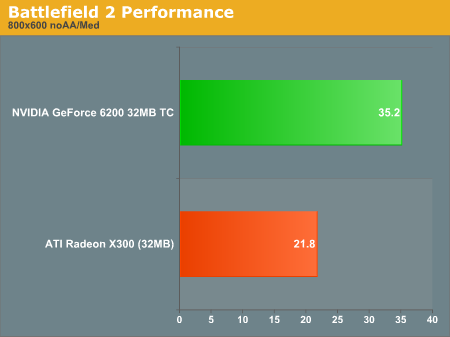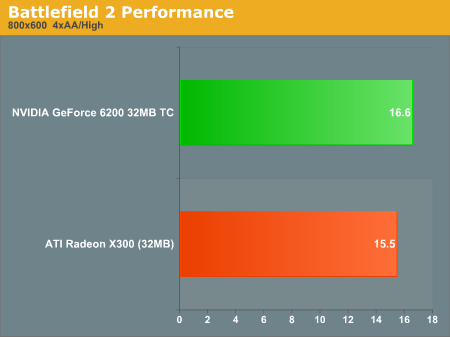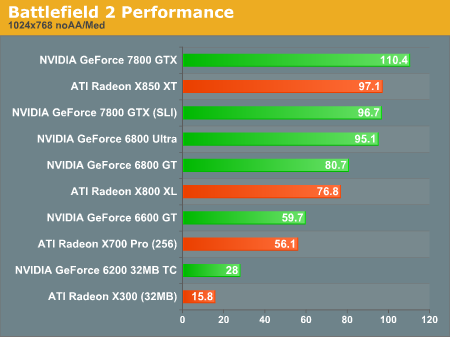Budget Performance Tests
For these tests, we ran only 800x600 and 1024x768. These are the only two resolutions that make any sense to run with Battlefield 2. 640x480 is all but unplayable as the text is mangled and layout gets broken. At 800x600, both cards do well, but the NVIDIA 6200 TurboCache maintains a performance lead here both with and without AA (though, the ATI card does close the gap when AA/AF are cranked up).

When we move up to 1024x768, the TurboCache card shows a little more capability than the HyperMemory part. Of course, both low end cards have very choppy performance at parts here. Tests with AA on at this resolution would have been a waste of time, and we strongly recommend playing the game at 800x600 without AA and Low Texture Filtering settings. In fact, turning down some of the options may help, but the player is at a disadvantage with less than maximal settings on view distance and shadows. Also, at this low resolution, we can see that an upgrade would offer playable frame rates at more than twice the performance. On high end parts, we are very CPU limited, and the SLI configuration is hampered because of added driver overhead.

Serious gamers will not want to play with these cards, but the casual gaming experience can be quite enjoyable. For a budget system, the ability to play current generation games without sacrificing shader effects will become more and more important as time goes on. As games rely more heavily on shading rather than simple textures and geometry to paint the experience, budget users will be glad that both ATI and NVIDIA offer options like these.










78 Comments
View All Comments
Questar - Thursday, July 7, 2005 - link
#10,Who told you that? An x700 has twice the pipes of a 9800pro, and is clocked much higher.
bob661 - Thursday, July 7, 2005 - link
Oh and I guess I'll be turning up the settings on my 6600GT.bob661 - Thursday, July 7, 2005 - link
#15I don't know about bias, but it would defintely not be scientific given the purpose of the article.
Aikouka - Thursday, July 7, 2005 - link
The point of these articles is to see how well the GPU scales as you change models. The article's focus is not in overall system performance in different price ranges, but how well different video cards perform against eachother and to do that, you kind of have to use the same hardware (with the exception of the card) or you really help to create a thing we like to call "bias."blckgrffn - Thursday, July 7, 2005 - link
I think that they could do a whole article with this engine and CPU performance + ram usage, let's hope if they do they don't neglect the AXP like they did for the HL2 benchmarks...Nat
jm20 - Thursday, July 7, 2005 - link
You have just benchmarked the highend, why not now cater to the rest (95%+) of the market. How many people pair a 6200TC with a FX-55? Do some realistic tests with a few different setups.Budget: AthlonXP 2000+, 512Mb ram, 8500/9000 pro
LowMid: AthlonXP-M @ 2.2-2.6Ghz, 512Mb ram, 9800 pro
HighMid: Athlon64 3200-3500+, 1Gb ram, 6800GT
Hacp - Thursday, July 7, 2005 - link
"(disclaimer: this is not actually possible)"LoL
Backslider - Thursday, July 7, 2005 - link
My 9600Pro does the job fine with med/high settings. When using 1GB of memory..jkostans - Thursday, July 7, 2005 - link
The X700 pro is essentially a 9800 pro but pci-e. So there's pretty much no difference in performance.geekfool - Thursday, July 7, 2005 - link
Where does the X800 Pure/XL/Pro fit in? And I'm sure that anyone with an Athlon FX 57 doesn't use GF 6200/ X300.